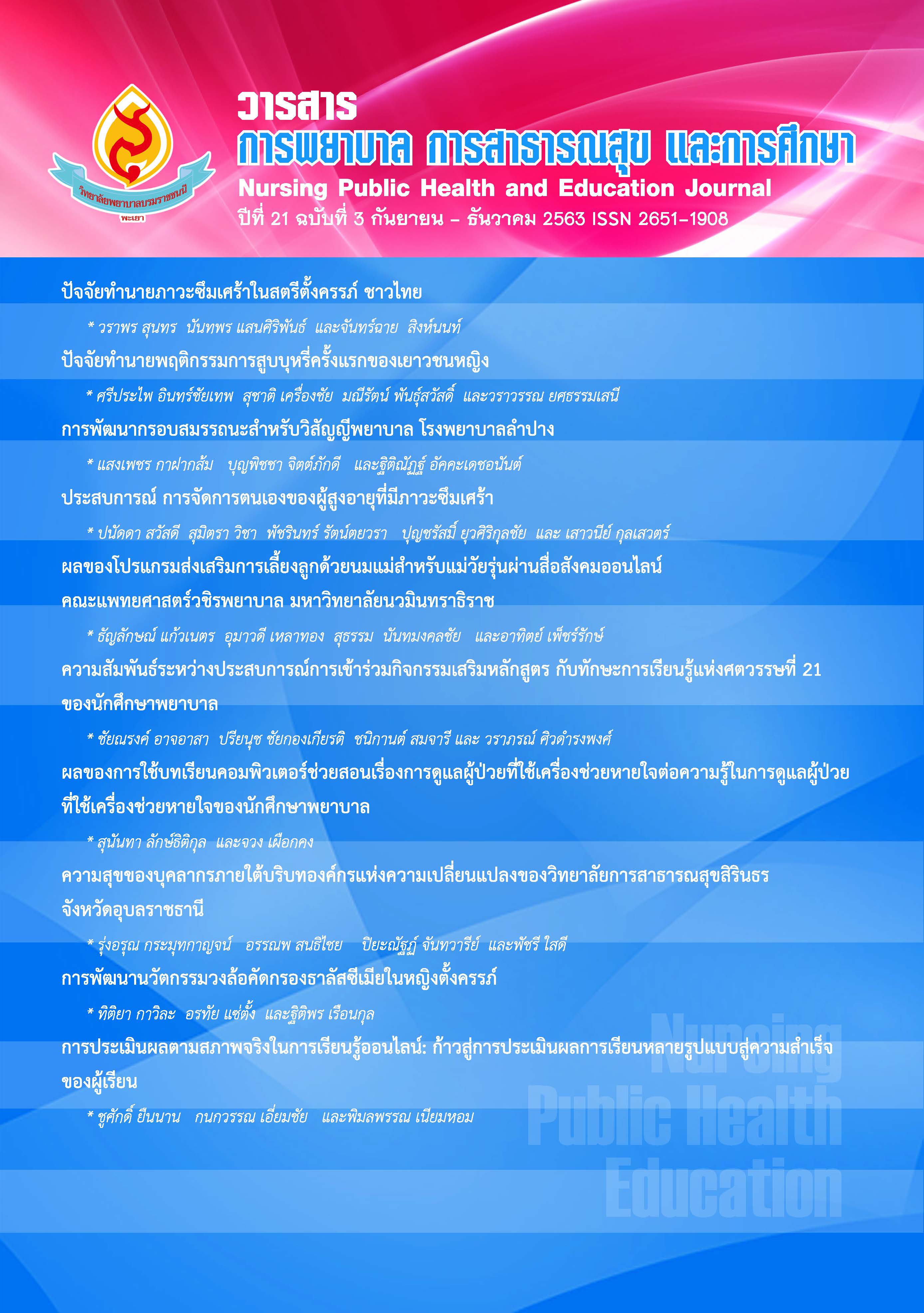การพัฒนากรอบสมรรถนะสำหรับวิสัญญีพยาบาล โรงพยาบาลลำปาง
คำสำคัญ:
การพัฒนา, กรอบสมรรถนะ, วิสัญญีพยาบาลบทคัดย่อ
สมรรถนะในการปฏิบัติงานของวิสัญญีพยาบาลพยาบาลส่งผลต่อความปลอดภัยของผู้ป่วยและคุณภาพทางการพยาบาล กรอบสมรรถนะจึงมีความสำคัญ เนื่องจากเป็นแนวทางในการพัฒนาทักษะของผู้ปฏิบัติงาน และการประเมินผลการปฏิบัติงานของผู้ปฏิบัติงานสำหรับผู้บริหาร การศึกษาเชิงพัฒนาครั้งนี้มีวัตถุประสงค์เพื่อพัฒนากรอบสมรรถนะสำหรับวิสัญญีพยาบาล โรงพยาบาลลำปาง โดยประยุกต์ใช้กลยุทธ์การพัฒนากรอบสมรรถนะของ มาเรลลี, ทอนโดรา, และฮอจ (Marrelli, Tondora, & Hoge, 2005) กลุ่มตัวอย่างประกอบด้วยวิสัญญีพยาบาล ในโรงพยาบาลลำปาง จำนวน 20 คน ซึ่งสุ่มตัวอย่างโดยใช้วิธีการสุ่มแบบง่าย และผู้ทรงคุณวุฒิที่ทำการการตรวจสอบกรอบสมรรถนะฉบับร่าง คัดเลือกแบบเจาะจง จำนวน 5 คน เครื่องมือที่ใช้ในการศึกษาครั้งนี้เป็นแนวคำถามกึ่งโครงสร้าง เก็บข้อมูลโดยการทบทวนวรรณกรรมที่เกี่ยวข้องและการสัมภาษณ์วิสัญญีพยาบาล วิเคราะห์ข้อมูลโดยการวิเคราะห์เนื้อหา และการหาค่าดรรชนีความตรงเชิงเนื้อหารายข้อ ผลการศึกษาครั้งนี้ได้กรอบสมรรถนะสำหรับวิสัญญีพยาบาล โรงพยาบาลลำปาง ประกอบด้วย สมรรถนะ 5 ด้าน และมี 51 พฤติกรรมบ่งชี้ความสามารถ ดังนี้ 1) สมรรถนะของวิสัญญีพยาบาลด้านการปฏิบัติการพยาบาลระยะก่อนการให้การระงับความรู้สึก ประกอบด้วย พฤติกรรมบ่งชี้ความสามารถจำนวน 13 ข้อ 2) สมรรถนะของวิสัญญีพยาบาลด้านการปฏิบัติการพยาบาลระยะระหว่างการให้การระงับความรู้สึก ประกอบด้วย พฤติกรรมบ่งชี้ความสามารถจำนวน 14 ข้อ 3) สมรรถนะของวิสัญญีพยาบาลด้านการปฏิบัติการพยาบาลระยะหลังการให้การระงับความรู้สึก ประกอบด้วย พฤติกรรมบ่งชี้ความสามารถจำนวน 8 ข้อ 4) สมรรถนะของวิสัญญีพยาบาลด้านการบริหารยาทางวิสัญญี ประกอบด้วย พฤติกรรมบ่งชี้ความสามารถจำนวน 3 ข้อ และ 5) สมรรถนะของวิสัญญีพยาบาลด้านการกระทำหัตถการ ประกอบด้วย พฤติกรรมบ่งชี้ความสามารถจำนวน 13 ข้อ ผลการศึกษาครั้งนี้ สามารถใช้เป็นแนวทางในการพัฒนาตนเองสำหรับตัววิสัญญีพยาบาล และสำหรับผู้บริหารสามารถนำไปใช้เป็นแนวทางในการพัฒนาบุคลากรให้มีสมรรถนะที่เหมาะสมกับการทำงานต่อไป
เอกสารอ้างอิง
กลุ่มภารกิจด้านการพยาบาล โรงพยาบาลลำปาง. (2559). คู่มือการบริหารการพยาบาลโรงพยาบาลลำปาง.โรงพยาบาลลำปาง
กาญจนา อุปปัญ, วินิตา จีราระรื่นศักดิ์, วราภรณ์ เชื้ออินทร์, ลักษณาวดี ชัยรัตน์, และปริณดา พรหมโคตร์. (2554). ภาวะใส่ท่อช่วยหายใจซ้ำภายใน 24 ชั่วโมง หลังการให้ยาระงับความรู้สึกโรงพยาบาลศรีนครินทร์: อุบัติการณ์และปัจจัยเสี่ยงที่ทำให้เกิด. ศรีนครินทร์เวชสาร, 26(4), 325-332.
กานดา เลาหศิลป์สมจิตร์. (2547). การศึกษาสมรรถนะของพยาบาลวิชาชีพด้านการพยาบาลวิสัญญี โรงพยาบาลรัฐ กระทรวงสาธารณสุข. วิทยานิพนธ์พยาบาลศาสตร์มหาบัณฑิต สาขาบริหารการพยาบาล จุฬาลงกรณ์มหาวิทยาลัย.
ธนพร เพชรหาญ. (2554). การพัฒนากรอบสมรรถนะของพยาบาลวิชาชีพ ห้องผ่าตัดศูนย์มะเร็งลำปาง. วิทยานิพนธ์พยาบาลศาสตรมหาบัณฑิต สาขาวิชาบริหารการพยาบาล มหาวิทยาลัยเชียงใหม่.
มยุรฉัตร ด้วงนคร. (2558). การพัฒนากรอบสมรรถนะของพยาบาลวิชาชีพ หอผู้ป่วยวิกฤตศัลยกรรม โรงพยาบาลเชียงรายประชานุเคราะห์. วิทยานิพนธ์พยาบาลศาสตรมหาบัณฑิต สาขาวิชาบริหารการพยาบาล มหาวิทยาลัยเชียงใหม่.
วิมลรัตน์ ศรีราช, อรลักษณ์ รอดอนันต์, นรุตม์ เรือนอนุกูล, และ ปัณณวิชญ์ เบญจวลีย์มาศ. (2562). ก้าวไกล วิสัญญี 4.0. กรุงเทพฯ: บริษัท ธนาเพรส จำกัด.
วิไลรัตน์ ใจพินิจ. (2557). การพัฒนาแบบประเมินสมรรถนะวิสัญญี โรงพยาบาลราชวิถี. วิทยานิพนธ์พยาบาลศาสตร์มหาบัณฑิต สาขาบริหารการพยาบาล จุฬาลงกรณ์มหาวิทยาลัย.
สถาบันพัฒนาและรับรองคุณภาพโรงพยาบาล. (มีนาคม 2561). Patient safety goals: SIMPLE. สืบค้นเมื่อ 11ตุลาคม 2562, จาก https://www.ha.or.th/Backend/ fileupload/เครื่องมือสนับสนุนการพัฒนาคุณภาพ/Attach/Patient%20Safety%20 Goals%20%20SIMPLE% 202008.pdf.
สภาการพยาบาล. (2553). สมรรถนะและการออกวุฒิบัตรรับรองความรู้ความชำนาญเฉพาะทางของผู้ปฏิบัติการพยาบาลขั้นสูง. กรุงเทพฯ: ศิริยอดการพิมพ์.
สมรัตน์ จารุลักษณานันท์. (2560). โครงการวิจัยสหสถาบัน เรื่อง การศึกษาอัตราการเสียชีวิต และภาวะแทรกซ้อน ทางวิสัญญีจากการรายงานอุบัติการณ์ในประเทศไทย. กรุงเทพฯ: สถาบันวิจัยระบบสาธารณสุข (สวรส.).
สำนักการพยาบาล. (2548). หน้าที่ความรับผิดชอบหลักและสมรรถนะพยาบาลวิชาชีพ. นนทบุรี: สำนักการพยาบาล กรมการแพทย์ กระทรวงสาธารณสุข.
สำนักการพยาบาล. (2551). มาตรฐานการพยาบาลโรงพยาบาล. (พิมพ์ครั้งที่3). นนทบุรี: สำนักการพยาบาล กรมการแพทย์ กระทรวงสาธารณสุข.
สุกัญญา เดชอาคม, อังศุมาศ หวังดี และอัญชลา จิระกุลสวัสดิ์. (2557). การพยาบาลผู้ป่วยในห้องพักฟื้น. วิสัญญีสาร. 40(1): 46-52.
House of Delegates. (1944). Standards for post anesthesia care. Retrieved October 10, 2019, from https:// www.asahq.org/media/sites/asahq/files/public/resources/standards-guidelines/standards-for-postanesthesia-care.pdf
NHS Education for Scotland (NES). (2011). Core competencies for anaesthetic assistant 3. Retrieved 11 October 2019, from https://www.nes.scot.nhs.uk/media/4239/anaesthetic_core_ competencies_2011 .pdf
Nunnally, M.E., O’Connor, M.F., Kordylewski. H., Westlake, B., &Dutton, R.P. (2015). The incidence and risk factors for perioperative cardiac arrest observed in the national anesthesia clinical outcomes registry. Anesthesia & Analgesia, 120, 364-370.
Marrelli, F. A., Tondora, J., & Hoge, A. M. (2005). Strategies for developing competency models. Administration and Policy in Mental Health, 32, 533-559.
Polit, D.F., & Beck, C.T. (2006). The content validity index: Are you sure you know what’s being reported?: Critique and recommendations. Research in Nursing & Health, 29, 489-497.
Webster, C.S., Merry, A.F., Larsson L, McGrath, K.A., & Weller, J. (2001). The frequency and nature of drug administration error during anesthesia. Anesthesia and Intensive care, 29(5): 494-500.
ดาวน์โหลด
เผยแพร่แล้ว
รูปแบบการอ้างอิง
ฉบับ
ประเภทบทความ
สัญญาอนุญาต
ลิขสิทธิ์ (c) 2020 วารสารการพยาบาลการสาธารณสุขและการศึกษา

อนุญาตภายใต้เงื่อนไข Creative Commons Attribution-NonCommercial-NoDerivatives 4.0 International License.



